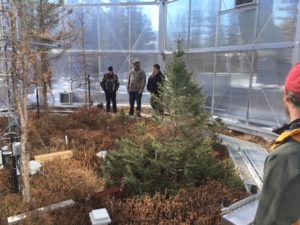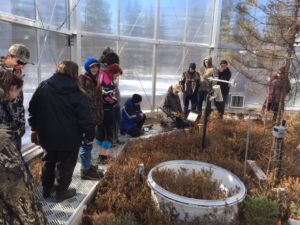On March 12th, 12 students from the Northern Lights Community School YES! team and their coaches ventured up to the Marcel Experimental Forest to learn about the Spruce Project. The Spruce Project is a longitudinal study of how Climate Change will affect the peat bogs of the northern hemisphere.
Our tour guides for the day were John Latimer, KAXE Staff Phenologist and research assistant for the Spruce Project and Dr. Stephen Sebestyen, Hydrologist for the United States Forest Service. They toured us through the site and explained the process of their research.
In a nut shell, the researchers are intending to study the effects of climate change on the Peatlands (Bogs) of the Northern Hemisphere. They are attempting to do this by increasing the ambient temperatures of 28 chambers measuring 40 feet in diameter and 30 feet tall, which were constructed in the bog. Two chambers are the control, where the ambient temperature is the same as the outdoor environment and one has an increased CO2 level to mimic the effects of an increased burning of fossil fuels. Each remaining chamber is heated by 2 degree Celsius with a maximum increase of 16 degrees Celsius and half of the chambers have an artificially increased CO2 level.
The experiment started in 2015 and is expected to run for 10 years, so currently they are only a small way into their research. Anecdotal observations showed us that the chamber heated to 16 degrees above the ambient temperature was drying out. The plants looked stressed under this extra heat load. The research goes beyond the surface of the bog, but monitors all aspects of the subterranean environment. Weekly they record evidence of the hydrology of the areas, root growth, chemical make up of the water, and so much more.

The expected outcome of the experiment is to directly observe the effects of climate change and make this information available to policy makers so they can make better informed decisions on how to manage and mitigate the effects of a changing climate. If you want to follow the research you can access their website at and read up on the latest findings as they are published.
This was a very fascinating tour and if you ever have the opportunity to visit the site you won’t be disappointed.